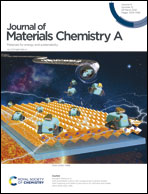Techno-economic analysis of metal–organic frameworks for adsorption heat pumps/chillers: from directional computational screening, machine learning to experiment†
Abstract
The key to achieving high efficiencies, high performance, and low costs of adsorption heat pumps/chillers (AHPs/ACs) is to choose a suitable adsorbent. A computational screening of 6013 computation-ready experimental metal–organic frameworks (CoRE-MOFs) is performed for methanol–MOF pairs in AHPs/ACs, and 137 953 hypothetical MOFs (hMOFs) are further directionally screened based on the range of optimal CoRE-MOF descriptors. Compared with the blind screening of CoRE-MOFs (∼13%), ∼80% of hMOFs obtained by the directional screening exhibited high performance in AHPs/ACs, proving the effectiveness of directional screening. Then, the techno-economic analysis (Ctotal) of AHPs/ACs for each MOF was performed based on the equipment cost (Cequipment), cycle cost (Ccycle), and material cost (CMOF). Cequipment accounted for the greatest proportion of Ctotal, but the proportion of Cequipment decreased and the proportion of Ccycle gradually increased as the MOF data set tended to be the materials with better performance. This confirmed the reduction of Ctotal by an effective enhancement of the Ccycle proportion, and that the high manufacturing cost of MOFs would not restrict their widespread use in AHPs/ACs. Among 6 machine learning (ML) algorithms, the random forest could yield the best prediction effect with little effect by the metal type of MOFs, whereas the heat of adsorption and MOF density were two key descriptors to determine Ctotal. 12 lowest-cost CoRE-MOFs and hMOFs were identified for each application, and their average costs in state 2 were only ∼1 USD kJ−1 in AHPs/ACs. Finally, a variant of the well-known MOF (Cu3BTC2) was predicted to possess superior techno-economy, which was confirmed by a parallel methanol adsorption experiment. These comprehensive insights from directional computational screening, ML algorithms to experiment can guide the development of low-cost and high-performance MOFs for AHPs/ACs in a variety of energy conservation and industrial applications.



 Please wait while we load your content...
Please wait while we load your content...